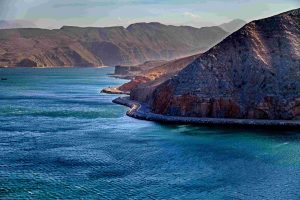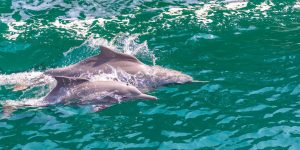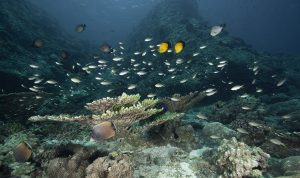Marine Environment of Oman
Introduction
The seas of the Sultanate of Oman occupy an isolated corner of the Indian Ocean, where some of the world’s most varied and biologically productive waters are found. In the Gulf of Oman and Arabian Sea, vast open ocean plains, canyons and trenches of extreme depth abruptly meet the coastline forming underwater cliffs several kilometers high. This contrasts with the gently sloping continental shelf of the Arabian Gulf and northern Gulf of Oman and has resulted in a great diversity of marine habitats.
Most of Oman’s waters lie within the tropics, but they nevertheless exhibit among the greatest seasonal variability found in any of the world’s oceans. The two main climatic influences are the winter and summer monsoons. The winter monsoon is characterized by a relatively gentle and variable, dry northeast wind, known locally as ‘Shamal’. This wind occurs between November and April, leading to modest increases in productivity and a current that flows to the southwest.
The vigorous summer monsoon, or ‘Kharif’, forcefully reverses this circulation pattern and has a dramatic effect on the Sultanate’s seas. Cold, nutrient-rich waters well up in the Arabian Sea, and once at the surface, sunlight triggers phytoplankton blooms that persist for three or four months of the year and fuel the region’s primary productivity.
Musandam Region

The ragged coastline of the Musandam region, includes spectacular cliffs that plunge into the sea along fjiord-like inlets and promontories that characterize the region’s coast. The shelter afforded by the many khayran, harbor some of the most well-developed corals reefs in the country, whilst the cliffs themselves provide a roosting place for seabirds. Offshore, the seabed slopes gently southwards into the Gulf of Oman.
The low-energy shoreline of the Batinah region in the Gulf of Oman, extends seaward as a wide continental shelf, that is generally desert-like and relatively featureless. A string of islands breaks the monotony; Oman’s only marine protected area, the Daymaniyat Islands Nature Reserve. Coral reefs thrive in clear waters and support a fantastic range of associated reef life, from sea anemones to Whale Sharks. The islands are also home to internationally important nesting seabirds and the critically endangered Hawksbill Turtle.
Al Batinah
The low-energy shoreline of the Batinah region in the Gulf of Oman, extends seaward as a wide continental shelf, that is generally desert-like and relatively featureless. A string of islands breaks the monotony; Oman’s only marine protected area, the Daymaniyat Islands Nature Reserve. Coral reefs thrive in clear waters and support a fantastic range of associated reef life, from sea anemones to Whale Sharks. The islands are also home to internationally important nesting seabirds and the critically endangered Hawksbill Turtle.
Muscat Region

The long-sweeping beach of the Batinah gives way to the rocky shores of Muscat, studded with coral reefs along a shoreline carved from limestone. Once used by ancient seafarers, the many bays, inlets and coves continue to shelter fishermen and attract tourists with their scenic splendor and promise of diverse and exciting marine life. Dolphins and whales are frequently seen in offshore waters that rapidly descend to depths of over 3,000 meters.
Ash-Sharqiyah
Rocky coastline extends southwards throughout much of the Sharqiyah region, reaching the easternmost tip of Arabia at the famous beaches of Ras al Hadd. Green Turtles nest here throughout the year in numbers that probably exceed those of any other turtle rookery in the Indian Ocean. The Wahiba Sands meet the shoreline south of Ras al Hadd, separating it from Oman’s other major turtle nesting site; the island of Masirah.
All four of Oman’s nesting turtles find space to nest on Masirah Island, but the majority are Loggerhead Turtles. As many as 30,000 females have been estimated to congregate here to nest between the months of March and August, forming possibly the largest nesting population in the world.
Al Wusta
Intense productivity in the waters of the Al Wusta region make the generally shallow seas here almost permanently green in colour. The vast swarms of phytoplankton attract a wealth of fish life, many of which apparently spawn here. Coastal whales, such as Humpback and Bryde’s Whales are attracted to this area and seabirds feed in their thousands. Onshore, still more birds, possibly over a million each year, dot the white sandy beaches and salt flats or wade in the shallows at Barr al Hikman, many of them passing through on migration.
Barr al Hikman is also special for another reason. A coral reef, perhaps thirty square kilometers in extent, lies in shallow waters off the south coast of the area and is uniquely made from a single coral species, the Oman Cabbage Coral.
Dhofar

Dhofar’s spectacular coasts and seas differ markedly from those further north in the country. Like Musandam, cliff’s plummet into the sea from coastal escarpments, whilst elsewhere khayran and sweeping beaches are reminiscent of Batinah or Muscat shorelines. At certain times of the year many of these beaches are criss-crossed by the tracks of turtles that return seasonally to nest.
The beaches below the spectacular headlands and cliffs of Ra’as Hamar, just half an hour’s drive west of Salalah, is one spot where it is possible, in late summer months, to watch both Green and Loggerhead Turtles nesting simultaneously.
However, it is here that the ‘Kharif’ is centred, turning both the shores and the seas green as it fuels prolific primary productivity.
The kharif begins in May, when southwesterly winds race across the Arabian Sea, driving surface waters seaward. Cold, nutrient- rich waters well up from the depths, spawning a tremendous abundance of marine life. Kelp-like algae flourish and form acres of swaying fields of seaweed, growing side-by-side with corals; a phenomenon that can only be witnessed in this part of the world. Fish life is spectacularly abundant, attracting large marine predators, like sharks, dolphins and whales in high numbers.
In undisturbed offshore areas, such as at the Halaaniyat Islands, pods of Sperm Whales may number over 50 individuals, whilst Arabian Long-Beaked Common Dolphins can school in thousands.
Source: ESO
